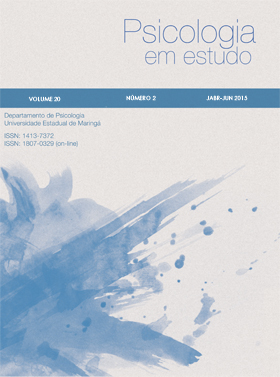MORTE, CULTURA, HEAVY METAL E EXPERIÊNCIA INTERNA: SENSAÇÃO E AFETIVIDADE
Resumo
O presente estudo buscou investigar as possíveis relações estabelecidas entre referenciais tanatológicos presentes no heavy metal e as experiências afetivas e sensoriais associadas à morte por partícipes deste campo de expressão artística e cultural. A pesquisa foi conduzida com base em metodologia introspeccionista de base qualitativa e idiográfica para o estudo da consciência, cujos procedimentos culminaram, em um primeiro momento na identificação e descrição das fenomenologias emergentes das referidas experiências; em um segundo momento na discussão dos processos cognitivos e afetivos subjacentes à emergência dos conteúdos fenomenológicos; e, em um terceiro e último momento na discussão de possíveis relações entre as fenomenologias reportadas e a circunscrição da morte no heavy metal. Tomados como um todo, os dados indicaram que, tanto no campo afetivo quanto no campo sensorial, a experiência interna do tema da morte entre os sujeitos reflete conhecidos parâmetros de representação da morte no ocidente, os quais parecem se sobrepor ao campo mais restrito de representação da morte no heavy metal.
Downloads
Referências
Ariès, P. (2012). A história da morte no ocidente. Rio de Janeiro, RJ: Nova Fronteira.
Barbosa, C.G., Melchiori, L.E., & Neme, C.M.B. (2011a). O significado da morte para adolescentes, adultos e idosos. Paidéia, 21(49), 175-185.
Barbosa, C.G., Melchiori, L.E., & Neme, C.M.B. (2011b). Morte, família e a compreensão fenomenológica: revisão sistemática de literatura. Psicologia em Revista, 17(3), 363-377.
Bardin, L. (2015). Análise de conteúdo. Lisboa: Edições 70.
Cave, S. (2012). Immortality: the quest to live forever and how it drives civilization. New York: Crown publishers.
Chalmers, D. (2010). The character of consciousness. New York: Oxford University Press.
Christe, I. (2010). Heavy metal: a história completa. São Paulo: Arx editora.
Fenwick, P. (2013). As experiências de quase morte (EQM) podem contribuir para o debate sobre a consciência?. Revista de psiquiatria clínica, 40(5), 203-207.
Gutiérrez, R.M.V., & Muñoz-Martínez, A.M. (2013). La regulación emocional: precisiones y avances conceptuales desde la perspectiva conductual. Psicologia USP, 24(2), 225-240.
Hales S, Gagliese L, Nissim R, Zimmermann C, Rodin G. (2012). Understanding bereaved caregiver evaluations of the quality of dying and death: an application of cognitive interviewing methodology to the quality of dying and death Questionnaire. Journal of pain and symptom management, 43(2), 195-204.
Hidalgo, C. (2010). Etnografias de la muerte: rituales, desapariciones, VIH-SIDA y resignificación de la vida. Buenos Aires: CICCUS.
Hurlburt, R.T. (2011). Investigating pristine inner experience: moments of truth. Cambridge: Cambridge University Press.
Kastenbaum, R. & Aisenberg, R. (1983). The psychology of death. New York: Springer.
Kovács, M.J. (2008). Desenvolvimento da tanatologia: estudos sobre a morte e o morrer. Paidéia, 18(41), 457- 468.
Kübler-Ross, E. (1996). Sobre a Morte e o Morrer. São Paulo: Martins Fontes.
Magalhães, J.H.G. (2014). O que as pessoas experienciam quando a morte vem à mente? Explorando aspectos cognitivos e fenomenais da experiência interna dirigida à morte entre sujeitos inseridos na cultura heavy metal. Dissertação de Mestrado Não-Publicada, Programa de Pós-graduação em Psicologia Cognitiva, Universidade Federal de Pernambuco, Recife.
Mandler, G. (2007). A history of modern experimental psychology: from James and Wundt to cognitive science. Massachusetts: The MIT press.
Nagel, T. (1974). What is it like to be a bat? The Philosophical Review, 83(4), 435-450.
Nascimento, A.M & Roazzi, A. (2007). A Estrutura da Representação Social da Morte na Interface com as Religiosidades em Equipes Multiprofissionais de Saúde. Psicologia: Reflexão e Crítica, 20(3), 435-443.
Nascimento, A.M. (2008). Autoconsciência situacional, imagens mentais, religiosidade e estados incomuns da consciência: um estudo sóciocognitivo. Tese de Doutorado Não-Publicada, Programa de Pós-graduação em Psicologia Cognitiva, Universidade Federal de Pernambuco, Recife.
Paivio, A. (2007). Mind and it’s evolution: a dual coding theoretical approach. Mauwah: Lawrence Erlbaum.
Pickering. J.(2000). Methods are a Message. In: Velmans, M (Org.), Investigating phenomenal consciousness: new methodologies and maps. (pp. 279-300). Amsterdam/Philadelphia: John Benjamins B.V.
Velmans, M. (2000). An Introduction to Investigating Phenomenal Consciousness. In: Velmans, M. (Org.), Investigating phenomenal consciousness: new methodologies and maps (pp. 1-18). Amsterdam/Philadelphia: John Benjamins B.V.
Pyszczynski, T., Greenberg, J., & Solomon, S. (1999). A dual-process model of defense against conscious and unconscious death-related thoughts: An extension of terror management theory. Psychological Review, 106, 835–845.
Roazzi, M,M., Dias, M..G.B.B & Roazzi, A. (2010). Mais ou menos morto: explorações sobre a formação do conceito de morte em crianças. Psicologia: Reflexão e Crítica, 23(3), 485-495.
Schmidt, B., Gabarra, L,M & Gonçalves, J.R. (2011). Intervenção psicológica em terminalidade e morte: relato de experiência. Paidéia, 21(50), 423-430.
Shihui, H., Qin, J. & Ma, Y. (2010). Neurocognitive processes of linguistic cues related to death. Neuropsychologia, 48, 3436–3442.
Salvagni, A., Savegnago, S.D.O., Gonçalves, j., Quintana, A.M., Beck, C.L.C. (2013). Reflexões acerca da abordagem da morte com crianças. Mudanças – Psicologia da Saúde, 21(2), 48-55.
Weinstein, D. (2000). Heavy Metal: the music and its culture. Boston: Da capo press.
Widera-Wysoczañska, A. (1999). Everyday awareness of death: a qualitative investigation. Journal of Humanistic Psychology, 39, 73–95.
As opiniões emitidas, são de exclusiva responsabilidade do(s) autor(es). Ao submeterem o manuscrito ao Conselho Editorial de Psicologia em Estudo, o(s) autor(es) assume(m) a responsabilidade de não ter previamente publicado ou submetido o mesmo manuscrito por outro periódico. Em caso de autoria múltipla, o manuscrito deve vir acompanhado de autorização assinada por todos os autores. Artigos aceitos para publicação passam a ser propriedade da revista, podendo ser remixados e reaproveitados conforme prevê a licença Creative Commons CC-BY.
The opinions expressed are the sole responsibility of the author (s). When submitting the manuscript to the Editorial Board of Study Psychology, the author (s) assumes responsibility for not having previously published or submitted the same manuscript by another journal. In case of multiple authorship, the manuscript must be accompanied by an authorization signed by all authors. Articles accepted for publication become the property of the journal, and can be remixed and reused as provided for in theby a license Creative Commons CC-BY.
















